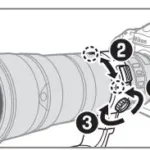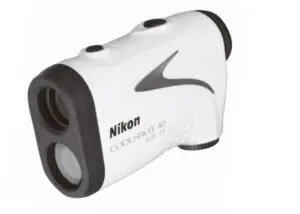
Nikon Coolshot 40 Instruction Manual
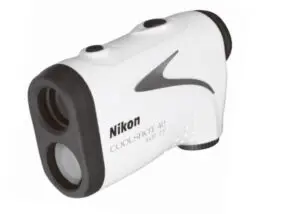
Introduction
Thank you for purchasing the Nikon Laser Rangefinder COOLSHOT 40.
Before using this product, please read these instructions thoroughly to ensure correct usage. After reading, please keep this manual handy for easy reference.
About the manual
- No part of the manual included with this product may be reproduced, transmitted, transcribed, stored in a retrieval system, or translated into any language in any form, by any means, without Nikon’s prior written permission.
- Nikon will not be held liable for any errors this manual may contain.
- The appearance of this product and its specifications are subject to change without notice.
About controls for radio interference
- This device complies with Part 15 of the FCC Rules. Operation is subject to the following two conditions:
(1) This device may not cause harmful interference, and
(2) This device must accept any interference received, including interference that may cause undesired operation. - This equipment has been tested and found to comply with the limits for a Class B digital device, pursuant to Part 15 of the FCC Rules and to EU EMC directive. These limits are designed to provide reasonable protection against harmful interference in a residential installation. This equipment generates, uses and can radiate radio frequency energy and, if not installed and used in accordance with the instructions, may cause harmful interference to radio communications. However, there is no guarantee that interference will not occur in a particular installation. If this equipment does cause harmful interference to radio or television reception, which can be determined by turning the equipment off and on, the user is encouraged to try to correct the interference by one or more of the following measures:
- Reorient or relocate the receiving antenna.
- Increase the separation between the equipment and receiver.
- Consult the dealer or an experienced radio/TV technician for help.
This Class B digital apparatus meets all requirements of the Canadian Interference-Causing Equipment Regulations.
About measurement results
This Nikon Laser Rangefinder is a basic rangefinder. Its results cannot be used as official evidence.
Cautions before use
Please observe the following guidelines strictly so you can use the equipment properly and avoid potentially hazardous problems. Before using this product, read thoroughly the “Cautions before use” and instructions on correct usage accompanying the product. Keep this manual within reach for easy reference.
WARNING
This indication alerts you to the fact that any improper use ignoring the contents described herein can result in potential death or serious injury.
CAUTION
This indication alerts you to the fact that any improper use ignoring the contents described herein can result in potential injury or material loss.
SAFETY PRECAUTIONS (Laser)
The Nikon Laser Rangefinder uses an invisible laser beam. Be sure to observe the following:
Warning
- Do not press the POWER ON/ Measurement button while looking into the optics from the objective side. Failure to do this may negatively affect or damage your eyes.
- Do not aim at the eye.
- Do not point the laser at people.
- Do not look at the laser with another optical instrument such as through lenses or binoculars, nor with the naked eye. This may result in damage to the eyes.
- When not measuring, please keep your fingers away from the POWER
ON/Measurement button to avoid accidentally emitting the laser beam. - When not in use for an extended period, please remove the battery from the body.
- Do not disassemble/remodel/ repair the Nikon Laser Rangefinder. The emitting laser may be harmful to your health. A product that has been disassembled/remodeled/ repaired is not guaranteed by the manufacturer.
- Keep the Nikon Laser Rangefinder out of reach of children when stored.
- If the Nikon Laser Rangefinder’s body cover is damaged, or if it emits a strange sound due to dropping or some other cause, remove the battery immediately and stop using.
SAFETY PRECAUTIONS
The Nikon Laser Rangefinder employs a monocular in its optical system in order to aim at the target. Be sure to observe the following:
Warning
- Never look directly at the sun, an intense light or the laser beam when using the Nikon Laser Rangefinder.
Cautions
- When not using the Nikon Laser Rangefinder, do not push the POWER ON/Measurement button.
- Do not use this product while walking. Failure to observe this may cause injury or malfunction as a result of walking into something, hitting others, falling
or other accidents. - Do not swing around by the strap. This may result in hitting others and cause injury.
- Do not place this product in an unstable place. Failure to observe this may result in falling or dropping and cause injury or malfunction.
- Keep the plastic bag used to wrap this product or other small parts out of reach of children.
- Prevent children from putting the rubber eyecup or small parts, etc. into their mouths. If children swallow such parts, consult a doctor immediately.
- If using the rubber eyecup for a long period of time, some people may suffer skin inflammation. If any symptoms occur, stop using it and consult a doctor immediately.
- When carrying the Nikon Laser Rangefinder, store it in the case.
- If your Nikon Laser Rangefinder should fail to operate correctly, discontinue use immediately and consult with your local dealer for instructions on where to send it for repair.
SAFETY PRECAUTIONS
(Lithium battery)
If handled incorrectly, the battery may rupture and leak, corroding equipment and staining clothing. Be sure to observe the following:
- Install the battery with the + and – poles positioned correctly.
- The battery should be removed when exhausted or during extended periods of non-use.
- Do not short the end terminal of the battery chamber.
- Do not carry together with keys or coins in a pocket or bag, it may short and cause overheating.
- Do not expose the battery to water, or a flame. Never disassemble the battery.
- Do not charge the lithium battery.
- If liquid from a damaged battery comes into contact with clothing or skin, rinse immediately with plenty of water. If liquid from a damaged battery enters the eyes, rinse immediately with clean water, then consult a doctor.
- When disposing of the battery, follow your local area regulations.
SAFETY PRECAUTIONS
Cautions
- It is not designed for use underwater.
- Rain, water, sand and mud should be removed from the rangefinder body surface as soon as possible, using a soft, clean cloth.
- Do not leave the Nikon Laser Rangefinder in a car on a hot or
sunny day, or near heat-generating equipment. This may damage or negatively affect it. - Do not leave the Nikon Laser Rangefinder in direct sunlight. Ultraviolet rays and excessive heat may negatively affect or even damage the unit.
- If the Nikon Laser Rangefinder is exposed to sudden changes in temperature, water condensation may occur on lens surfaces. Do not use the product until the condensation has evaporated.
CARE AND MAINTENANCE
Lenses
- When removing dust on the lens surface, use a soft oil-free brush.
- When removing stains or smudges like fingerprints from the lens surface, wipe the lenses very gently with a soft clean cotton cloth or quality oil-free lens tissue. Use a small quantity of pure alcohol (not denatured) to wipe stubborn
smudges. Do not use velvet cloth or ordinary tissue, as it may scratch the lens surface. Once the cloth has been used for cleaning the body, it should not be used again for the lens surface.
Main body
- Clean the body surface with a soft, clean cloth after blowing away dust with a blower* lightly. Do not use benzene, thinner, or other cleaners containing organic solvents.
* A blower is rubber cleaning equipment that blows air from a nozzle.
Storage
- Water condensation or mold may occur on the lens surface because of high humidity. Therefore, store the Nikon Laser Rangefinder in a cool, dry place. After use on a rainy day or at night, thoroughly dry it at room temperature, then store in a cool, dry place.
Symbol for separate collection applicable in European countries
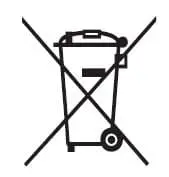 This symbol indicates that this battery is to be
This symbol indicates that this battery is to be
collected separately. The following apply only to users in European
countries.
- This battery is designated for separate collection at an appropriate collection point. Do not dispose of as household waste.
- For more information, contact the retailer or the local authorities in charge of waste management.
Key features
- Measurement range: 7.5-590 meters/8-650 yards
- High-quality 6x finder with multilayer coating
- Larger ocular for easy viewing
- First Target Priority mode is employed
- Single press of the button provides approx. 8-second continuous measurement
- Automatic power shut-off (after approx. 8 sec. unoperated)
- Default to “Last Use” settings
- Rainproof — JIS/IEC protection class 4 (IPX4) equivalent (under our testing conditions)
- Invisible/Eyesafe EN/IEC Class 1M Laser
The Nikon Laser Rangefinder uses an invisible laser beam for measuring. It measures the time the laser beam takes to travel from the rangefinder to the target and back. Laser reflectivity and measurement results may vary according to climatic and environmental conditions, as well as the color, surface finish, size, shape and other characteristics of the target.
The following conditions facilitate measuring:
- Cloudy weather
- Bright-colored target
- Large-size target
- When laser incidence to the target’s reflective surface is straight
Measurement may be inaccurate or fail in the following cases:
- In snow, rain or fog
- Small or slender target
- Black or dark target
- Target has stepped surface
- Moving or vibrating target
- When measuring the surface of water
- Target measured through glass
- When the target is glass or a mirror
- When laser incidence to the target’s reflective surface is oblique
Nomenclature/Composition
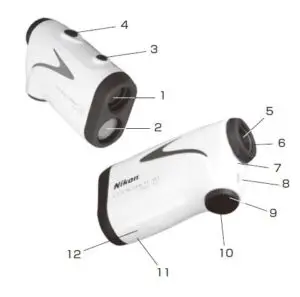
- Monocular objective lens/
Laser emission aperture - Laser detector aperture
- MODE button
- POWER ON/Measurement button
- 6x monocular eyepiece
- Eyecup/Diopter adjustment ring
- Diopter index
- Strap eyelet
- Battery chamber cover “Open” indication
- Battery chamber cover
- Product number label
- Indication

Internal display

- Aim at the target you want to measure.
Position the target at the center of the reticle. - Now measuring
- Appears while the laser is being irradiated for a measurement.
Do not look towards the objective lens side while this mark is shown. - “Failure to measure” or “Unable to measure”
Because the internal display of this product is enlarged by the eyepiece, dust may sometimes be seen. This will not, however, affect the measurement accuracy.
Target priority mode
This Nikon Laser Rangefinder employs First Target Priority mode. When measuring overlapping subjects, it displays the distance of the closest subject.
Distance display units
Measurement results are displayed in yards/meters.
(Factory default setting is yard.)
- Turn on the power.
- Press and hold the MODE button for more than two seconds. After the display unit has switched, release the button.
Battery
- Type of battery
3V CR2 lithium battery x1 - Inserting/replacing battery
- Open the battery chamber cover
Rotate the battery chamber cover counterclockwise and remove it. It may not open easily due to its rubber
packing for water resistance. - Insert the battery/Replace the old battery with a new one Insert a new battery correctly positioned following the indication seal inside the chamber. The [+] pole should be positioned toward the inside of the chamber. If the battery is not inserted correctly, the Nikon Laser Rangefinder will not operate. When replacing the battery, remove the old battery then insert a new one.
- Close the battery chamber cover Rotate the battery chamber cover clockwise to screw it into the body. It may not close easily due to the rubber packing for water resistance, but continue to turn it all the way until it stops. Confirm that the cover is securely closed
Battery level indicator
- The battery condition mark in the internal display warns when the battery needs to be replaced.

Battery life
Continuous operation: Approx. 1,400 times (at approx. 20°C) This figure may differ according to conditions, temperature, and other factors such as target shape, color, etc. Use only as a guide.
- The battery supplied with this Nikon Laser Rangefinder is for operation checking. Due to natural electrical discharge, the life of this battery will likely be shorter than that noted above.
- If water enters the battery chamber due to submersion, dry the battery chamber well, then replace the battery.
Measurement
Caution — Controls, adjustments or usage of procedures other than those specified herein may produce negative effects or damage to your health due to laser radiation.
Preparing
Install a battery in the battery chamber. (See “Battery”)
Diopter adjustment
Adjust the diopter to obtain a clear internal display in the viewfinder. First, rotate the diopter adjustment ring counterclockwise until it comes to a complete stop. Next, rotate the diopter adjustment ring back and forth until the internal display comes into focus.
Measuring
Before measuring, be sure to confirm the Distance display unit setting.
Turn on the power.
Automatic power shut-off after approx. 8 seconds unoperated.

Aim at the target.
Position the target at the center of the target mark.
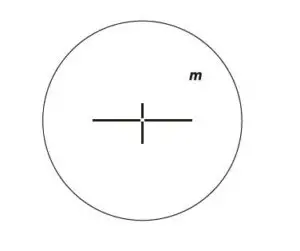
Press the POWER ON/Measurement button once to start continuous measurement for approx. 8 seconds. During measurement, the measured result is displayed consecutively while the laser irradiation mark is blinking.
After measurement, the result is displayed for approx. 8 seconds, then power automatically turns off. If you press the POWER ON/Measurement button during power-on, another 8-second continuous measurement starts.

When measuring a flagstick at a golf course, for example, keep targeting the flagstick at the center of the target mark to minimize handshake.
Specifications

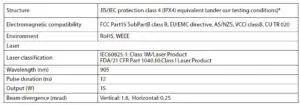
Water resistance performance
This Nikon Laser Rangefinder is equivalent to JIS/IEC protection class 4 (IPX4) (under our testing conditions). This rating does not guarantee the water resistance performance of the unit or that it will be free from damage or problems under
all conditions. Please observe the following when using:
- The unit is not a sealed structure, so it should not be operated nor held in running water.
- If any moisture is found on movable parts of the unit, stop using it and wipe it off.
Troubleshooting/Repair
If the Nikon Laser Rangefinder fails to function as expected, check the list before consulting your local dealer or the store where you purchased it.
- If there is a problem with the product.

If you require a repair, please contact your local dealer or the store where you purchased the product.
Do not repair or disassemble. It may result in a serious incident.
Please note that Nikon is not responsible for any direct or indirect damage if the user attempts repair or disassembly.
